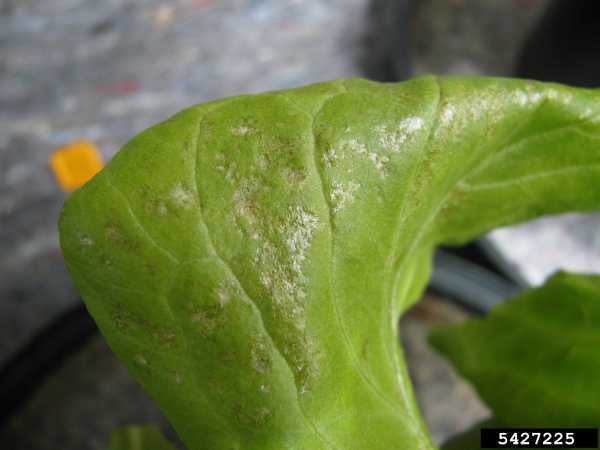Take Lettuce Pests Head On

Effects of Western Flower Thrips on lettuce. Frank Peairs, Colorado State University, Bugwood.org.
Growing lettuce in the Southwest presents a unique set of challenges, and pest pressure is at the top of the list.
According to John Palumbo, Extension Entomologist from the Department of Entomology at the University of Arizona, there are four major pests of lettuce in the Southwest. These include the complex of lepidopteran pests, sweet potato whitefly, western flower thrips, and aphids.
Changing With The Seasons
Palumbo says the four pests dominate in different growing seasons. In the fall, the presence of lepidopteran pests (which include beet armyworm, cabbage looper, and corn earworm) and the sweet potato whitefly is heightened, while western flower thrips and aphids predominate in the cooler spring temperatures.
“[Whiteflies and lepidopteran] insects are cold blooded, so the warmer it is, the more active they are. Their biology is accelerated, they’re more reproductively active, and they move more in warmer temperatures. On the flipside, aphids and thrips do better under cooler temperatures,” he explains.
Palumbo mentions rising temperatures in Arizona have created an uptick in pest populations, and the past two winters in Yuma, AZ, have been “practically nonexistent.”
“We’ve basically had no freeze events at night. We’ve had very warm winters relatively speaking, and during the fall of 2014 we also had very warm temperatures. That really exasperated the lepidopterans and some other insects. The pest pressure seems to be prolonged well into mid-November. As it cools down, pest pressure tends to decline pretty rapidly, but this year, not so much because it’s been so warm,” he says. However, for the past three weeks, temperatures have been much cooler and pest pressure is down as well.
Major Crop Losses
Of the four pests, Palumbo says that the lepidopterans cause growers the most trouble.
“The lepidopterans are year in and year out, consistently the most damaging pest. They are the pest that require the most control, and growers will spend more money on those than they will anything else,” he says.
When plants are small, feeding damage from worms can cause severe reduction to stand establishment, dramatically diminishing the number of plants in the field. Palumbo notes, however, that as plants increase in size they’re generally able to tolerate the damage better, but as harvest nears, the risk of loss increases as worms feed on or contaminate the marketable product.
Palumbo says that corn earworm has been particularly troubling to growers in the late fall and spring. “We’ve had fields that have been rejected because of high contamination of worms in the lettuce heads. Again, the acreage is very small when this occurs, but nonetheless, that, in particular, has been a pretty tough deal the last two years,” he says.
Taking Control
Palumbo notes that IPM practices in the area are insecticide intensive. “When it comes to control, its predominately chemical control, no question about it,” he says.
“We’ve seen a dramatic shift in the 25 years I’ve been here from a heavy reliance on organophosphates, carbanates, and pyrethroids, to now using the newer reduced-risk pesticide products.”
He mentions, however, that growers are still using broad-spectrum insecticides because the system is so pest intensive.
“[Growers] are still using pyrethroids, but often times in combination with a selected soft chemistry to try to cover all their bases. Overall, however, they’re using really soft, reduced-risk chemistries for the most part,” Palumbo says.
An example of a commonly used reduced-risk insecticide applied by Arizona growers is Radiant (Dow AgroSciences) that effectively control lepidopteran larvae and western flower thrips. Palumbo also mentions the use of Admire Pro (Bayer CropScience), for systemic control of whiteflies and aphids, which is applied directly to the soil.
Also, more and more growers in the area are banding their insecticides, Palumbo notes, which has helped reduce costs.
“When growers can get into the field with ground equipment, a lot of times they’ll band down, and they can cut their insecticide costs in half, if not more. That’s becoming more and more standard locally.”
As for organics, Palumbo says the number one product used to control lepidopteran pests as well as the Western flower thrips is Entrust (Dow AgroSciences).
He also says that some growers have experimented with beneficial insects, but with varying success.
“With the beneficials, because of the intensity of the pest pressure, how quickly these crops are in and out of the ground, and the fact that the quality is so important, they just can’t keep up with the expectations of the shippers and the growers,” he explains.
A Holistic Approach
One of the most important things for you to do to reduce pest pressure in lettuce is scouting, Palumbo says.
“Our surveys tell us that 100% of the acreage — of the lettuce acreage in particular — is scouted. In the fall when things are really going, PCAs (pest control advisors) generally scout a field about four times a week, and in the spring about three times a week,” he explains.
To scout, Palumbo says you should get down into the fields when the plants are approximately at the one-leaf stage, and crawl. It’s at this stage that the plants are the most susceptible to damage from worms and whiteflies. When plants start to increase in size, it’s time to start cutting them and closely inspecting, he says.
Another important practice is crop placement. For example, keep your lettuce away from crops such as corn or alfalfa, which can harbor summer pests including armyworm, whiteflies, and thrips.
“Be aware of what’s around you, that’s first and foremost. When the crop goes in the ground, what’s the surrounding habitat like? Are you near desert vegetation? Are you near some of these other crops like cotton and alfalfa? If you are going to have a migration of pests, it will likely come from one of those areas,” he explains.
Sanitation is another critical factor to keep pests at bay.
“Yuma growers are very conscious of weeds in vacant areas, and they try to keep those eliminated. When they’re irrigating fields to try to get them ready for the next crop they’re quick to get rid of any weeds that may emerge, whether they burn them down with an herbicide or disk them down,” he says.
Communication Is Key
One aspect of crop protection Palumbo says growers usually overlook and can help mitigate stress associated with pest pressure, is communication.
Communicating with your PCAs, your labor crew, and your tractor foreman, to name a few, is key, he explains.
“For example, what’s going on in the farming end versus what are my needs in terms of controlling an insect,” he says.
“Is there a hoe crew scheduled to come in within the next day or so? When are you going to irrigate? When is the last date I can spray? When do you expect to have a harvest crew in the field? That will control what you can spray based on the pre-harvest interval. A lot of little things like that go on day to day, and you should be asking those questions.”
Palumbo suggests to not only communicate with those at your operation, but also with packers and shippers to stay on the same page and eliminate any potential confusion.









